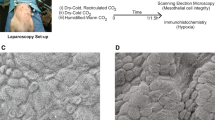Abstract
Background: A variety of mechanisms have been proposed to explain tumor growth in port sites following laparoscopic cancer surgery. We devised two experimental models to determine whether carbon dioxide (CO2) insufflation during laparoscopic surgery influences the movement of tumor cells and leads to tumor implantation and growth in surgical wounds.
Methods: Model 1: Viable adenocarcinoma cells were introduced into the upper abdomen of six syngeneic immune-competent rats during laparoscopy with CO2 insufflation; the same procedure was followed for a further six rats during gasless laparoscopy. A length of plastic tubing introduced through the anterolateral aspect of the rats' left lower abdominal wall was used to vent the insufflation gas through the abdomen of a recipient rat for 30 min. After 21 days, the peritoneal cavity and surgical wounds of the recipient rat were examined for implanted tumor. Model 2: A suspension of radiolabeled adenocarcinoma cells was introduced into the upper abdomen of five rats during laparoscopy with CO2 insufflation and an additional five rats during gasless laparoscopy. A length of plastic tubing introduced through the anterolateral aspect of the left lower abdominal flank was used to vent the insufflation gas through phosphate-buffered saline solution. After 30 min, the solution was counted for radioactivity.
Results: Tumor growth occurred at the site of both the insufflation and venting ports in the second rat in five of the six rats from the group undergoing insufflation, but it was found in none of the gasless laparoscopy group (p= 0.015). In the second model, significant transfer of tumor cells to the vented gas occurred only in the rats undergoing laparoscopy with insufflation (median, 2.71% versus 0% of the introduced labeled cells; p= 0.008).
Conclusions: Carbon dioxide insufflation results in tumor dissemination during laparoscopy, leading to port site metastasis. Gasless laparoscopy may prevent this problem.
Similar content being viewed by others
Author information
Authors and Affiliations
Additional information
Received: 17 March 1997/Accepted: 6 June 1997
Rights and permissions
About this article
Cite this article
Mathew, G., Watson, D., Ellis, T. et al. The effect of laparoscopy on the movement of tumor cells and metastasis to surgical wounds. Surg Endosc 11, 1163–1166 (1997). https://doi.org/10.1007/s004649900561
Published:
Issue Date:
DOI: https://doi.org/10.1007/s004649900561




